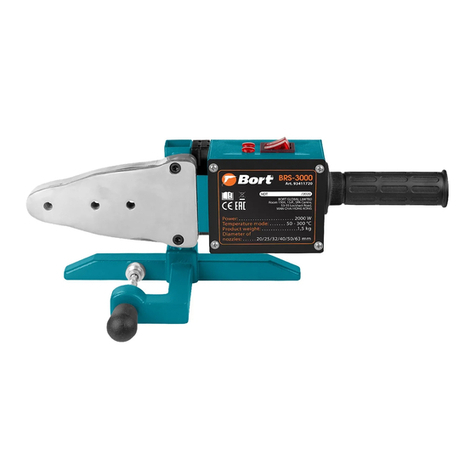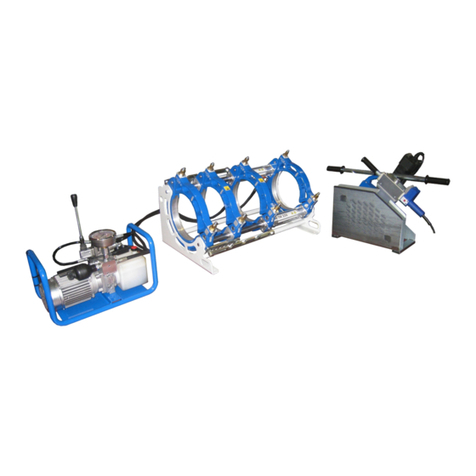PowR-Quip Contractor Series User manual


SPECIFICATIONS SUBJECT TO CHANGE WITHOUT NOTICE
2

SPECIFICATIONS SUBJECT TO CHANGE WITHOUT NOTICE 3
To help us serve you better do not hesitate to contact us if you have any problems or suggestions.
This manual has important information for installation, operation and maintenance of your equipment. It is very
important to read this manual carefully before starting your equipment.
Always keep this owner´s manual in a safe place for further reference.
IMPORTANT SAFETY INFORMATION INDICATES HOW TO PREVENT
DAMAGE TO EQUIPMENT AND PERSONAL SAFETY INSTRUCTIONS
IMPORTANT
INDICATIONS

SPECIFICATIONS SUBJECT TO CHANGE WITHOUT NOTICE
4
14
15
16
8
9
10
11
12
13
1
1
2
6
3
5
4
7
2
1
DESCRIPTION
UNPACKING
SAFETY MEASURES
These units are provided with four strokes air cooled
engines designed to run at 3750 RPM max. and
continuously deliver a current corresponding to its
rated power. In these models a device is provided for
automatic engine turning off when the engine has low
oil level, so protecting it. This characteristic is generally
associated with long running models.
The alternator is thermally protected. To operate this unit
as a generator or a welder, place the front panel switch
according to what you want.
When you unpack, inspect carefully for any damage
that may had occurred during shipment. Make sure that
any xture, screws, etc., are tightened before operating
the unit.
Report any missing item by contacting the place of
purchase.
Before starting or servicing the welder/generator, read
and understand all instructions. Failure on complying
with safety precautions or instructions can cause
damage to the equipment and/or personal injury or
death.
The instructions about the engine for these units are
included in a separate manual. Keep all the manuals
for future references.
Never use this welder/generator for any application
other than that specied by the manufacturer. Never
operate this welder/generator under conditions not
approved by the manufacturer. Never attempt to modify
the equipment to operate in a way other than that for
which it was designed.
For maintenance and repairs use only products and
original components.
Before operation, make sure your equipment is properly
connected to ground. For proper grounding procedures
refer to “grounding instructions” section in this manual.
Make sure that your equipment is used only by persons
who have read and understood these instructions.
If your welder/generator is going to be in a xed place,
hold it rmly to the oor (use anchors, expansive dowels
or similar) if not, make always sure that it will not move
with the vibrations.
Keep all persons away from the equipment during its
operation. Do not allow people wearing jewelry or loose
clothing manage the equipment, since these can be
caught by moving parts, causing damage to equipment
and/or personal injury. Keep the people away from
movable pieces or that which can become hot during
functioning.
Be sure that all electrical appliances are switched off
before connecting them to your equipment.
Keep always the welder/generator clean and well
maintained.
NEVER OPERATE THIS WELDER/GENERATOR IN AN
EXPLOSIVE OR FLAMMABLE ENVIROMENT OR IN
AREAS WITH INSUFFICIENT VENTILATION.
Be sure that all tools and accessories are well prepared
for use and are properly grounded. Use one phase tools
or apparatus provided with three-prong plug power cord.
If an extension cord is used, be sure this has three- prong
plugs with a suitable ground connection..
DO NOT OPERATE YOUR EQUIPMENT ON WET
SURFACES OR UNDER THE RAIN.
TURN OFF AND DISCONNECT THE SPARKPLUG
WIRE BEFORE PERFORMING ANY SERVICE OR
MAINTENANCE TO THE UNIT.
Use only unleaded fuel. Do not ll the fuel tank with the
engine running. Take precautions to avoid spilling of
fuel while lling the tank. Make sure that fuel tank cap is
securely in place before starting the engine. Clean any
spilled fuel before starting the engine. Allow engine to
cool for at least two minutes before lling the tank.
This welder/generator can be used for auxiliary
emergency electrical service, in these cases, a double
throw switch shall be installed between the entrance main
switch and the electrical distribution box. This switch must
be installed by a licensed electrician
NEVER MIX OIL WITH GASOLINE. THIS FOUR-
STROKE ENGINE IS DESIGNED TO BE FUELED WITH
PURE GASOLINE. OIL IS ONLY USED FOR ENGINE
LUBRICATION
KEEP ALWAYS ACCESSIBLE A FIRE EXTINGUISHER
WHILE YOU ACCOMPLISHE ARC WELDING WORKS.
All installation, maintenance, repair and operation of this
equipment shall be carried out by persons qualied in
accordance with national, state and local codes.
THE INAPPROPRIATE USE OF ELECTRIC ARC
WELDING WELDERS CAN CAUSE INJURY,
ELECTRIC SHOCK AND EVEN DEATH. TAKE ALL
PRECAUTIONS DESCRIBED IN THIS MANUAL TO
REDUCE THE POSSIBILITY OF ELECTRIC SHOCK
Check that all components of the arc welder are clean
and in good condition prior to operating the welder. Make
sure that the insulation of all cables, electrode holders
and power cords are not damaged. Always repair or
replace damaged components before operating the
welder. Always keep panels, guards, etc. of the welding
machine in place when you operate.
Wear always dry protection clothing, welder gloves and
insulated footwear.
Always operate the welding machine in a clean, dry and
well-ventilated area. Do not operate the welding machine
in humid, wet, rainy areas or with insufcient ventilation.
Make sure that the work piece is properly supported
and grounded prior to begin any electric arc welding
operation.
You must stretch the welding cable before use to avoid
overheating and damage to the cable insulation.
18
17
19
20

SPECIFICATIONS SUBJECT TO CHANGE WITHOUT NOTICE 5
30
29
21
22
23
24
25
26
27
28
NEVER IMMERSE THE ELECTRODE OR ELECTRODE
HOLDER IN WATER. IF THE WELDING MACHINE
IS WET FOR ANY REASON, BE SURE THAT IT
IS COMPLETELY CLEAN AND DRY BEFORE
ATTEMPTING TO USE IT.
Always shut down your equipment before moving the unit.
Always attach rst the work conductor.
Check that the work piece is positively grounded.
Always shut the electric welder off and remove the
electrode from the holder when welder is not in use.
Never allow any part of the human body to touch the
work electrode and ground or the grounded work piece
at the same time.
The human body conditions and inconvenient body
positions while welding can cause electrical shock
hazard. When crouching, kneeling or at elevations, be
sure to insulate all conductive parts, wear appropriate
protective clothing and take precautions to prevent
injuries caused by falls.
Never attempt to use this equipment with current
settings or duty cycles higher than those specied on
the equipment labels.
Never use an electric arc welder to thaw frozen pipes.
THE DETACHED SPARKS AND HOT METAL CAN
CAUSE INJURIES.
AS THE WELDS TURNS COLDER IT IS POSSIBLE
THAT DETACHMENT OF SLAGS OCCUR. TAKE ALL
PRECAUTIONS DESCRIBED IN THIS MANUAL TO
REDUCE THE POSSIBILITY OF INJURIES CAUSED
BY SPARKS AND HOT METAL DETACHMENTS.
When chipping or grinding metal parts wear approved
by ANSI protective helmet or safety glasses with side
protection. Use ear plugs when welding above your head
to prevent spatter or slag falling into your ears.
ELECTRIC ARC WELDING OPERATIONS PRODUCE A
BRIGHT LIGHT AND HEAT, AND ULTRAVIOLET (UV)
RAYS. THIS MAY CAUSE INJURIES TO THE EYES
AND SKIN. TAKE ALL PRECAUTIONS DESCRIBED
IN THIS MANUAL TO REDUCE THE POSSIBILITY OF
INJURY.
All persons using this equipment or who are in the area
while the equipment is being used shall use protective
equipment that includes: helmet or protective welding
glass shade 10, wear resistant to ames, leather welding
gloves and full foot protection.
NEVER SEE THE OPERATIONS OF ARC WELDING
WITHOUT EYE PROTECTION DESCRIBED ABOVE.
NEVER USE DARK FILTER LENSES THAT ARE
CRACKED, BROKEN OR UNDER 10 SHADOW
CLASSIFICATION. WARN OTHERS IN THE AREA
THAT THEY DO NOT SEE THE ARC.
ELECTRIC ARC WELDING OPERATIONS CAUSE
SPARKS AND HOT METALAT TEMPERATURES THAT
CAN CAUSE SERIOUS BURNS. WEAR GLOVES AND
PROTECTIVE CLOTHING WHEN PERFORMING ANY
METAL WORK.
33
34
31
32
35
36
TAKE ALL PRECAUTIONS DESCRIBED IN THIS
MANUAL TO REDUCE THE POSSIBILITY OF BURNS
ON THE SKIN AND CLOTHING.
Make sure that all persons in the area of doing welding
are protected from heat, sparks, and ultraviolet rays. Use
additional protection for face and ame resistant barriers
as needed.
Never touch work pieces until they have completely
cooled down.
HEAT AND SPARKS PRODUCED DURING SOME
WELDING WORKS AND OTHER METAL WORKING
OPERATIONS CAN IGNITE FLAMMABLE AND
EXPLOSIVE MATERIALS. TAKE ALL PRECAUTIONS
DESCRIBED IN THIS MANUAL TO REDUCE THE
POSSIBILITY OF FLAMES AND EXPLOSIONS.
Remove all ammable materials within a radius of 35 feet
(11 meters) away from the place where the welding work
is being performed. If it is not possible to remove them
tightly cover ammable materials with reproof covers.
Take precautions to make sure that sparks ying and
the heat do not cause ames in hidden areas, behind
screens, etc.
FIRE HAZARD. DO NOT WELD ON CONTAINERS
OR PIPES THAT CONTAIN OR HAVE CONTAINED
FLAMMABLE OR COMBUSTIBLE LIQUIDS
MATERIALS.
SOLDERING OF CYLINDERS OR CLOSED TANKS OR
DRUMS CAN CAUSE EXPLOSION IF APPROPRIATE
HOLES HAVE NOT DONE ON THEM.
VERIFY THAT ANY CYLINDER OR CLOSED
CONTAINER TO BE SOLDERED HAS A SUITABLE
VENTILATION HOLE, SO THAT EXPANDING GASES
CAN BE RELEASED.
DO NOT BREATHE FUMES PRODUCED BY THE
ARC WELDING PROCESS. THESE GASES ARE
DANGEROUS.
IF THEAREA OF WELDING CAN NOT BE VENTILATED
PROPERLY, BE SURE TO WEAR A RESPIRATOR
WITH A TANK OF OXYGEN.
Keep head and face away from the welding gases.
Do not perform electric arc welding operations on metals
that are galvanized or cadmium plated, or contain zinc,
mercury, or beryllium, without completing the following
precautions:
a. remove the coating from the base metal.
b. make sure that the area of soldering it is well ventilated.
c. use a respirator with oxygen.
Extremely toxic gases are created when these metals
are heated.
THE ELECTROMAGNETIC FIELD THAT IS
GENERATED DURING ARC WELDING CAN INTERFER
THE OPERATION OF VARIOUS ELECTRICAL AND
ELECTRONIC DEVICES, FOR EXAMPLE CARDIAC
PACEMAKERS. PEOPLE WHO USE SUCH DEVICES
SHOULD CONSULT WITH A DOCTOR BEFORE
MAKING ANY ELECTRIC ARC WELDING OPERATION

SPECIFICATIONS SUBJECT TO CHANGE WITHOUT NOTICE
6
38
37
39
40
ADDITIONAL SAFETY MEASURES
PRECAUTIONS FOR NOISE
LOCATION GENERAL
GENERAL OPERATION
Route the electrode and work cables together and secure
with tape when possible.
Never wrap the welder cables around the body.
Always place the electrode and work connectors so that
they are on the same side of the body.
Exposure to electromagnetic elds during welding may
have other health effects which are unknown.
MAKE ALWAYS SURE THE AREA OF SOLDERING
IS SAFE AND FREE OF HAZARDS (SPARKS,
FLAMES, THE RED METAL OR SLAG) BEFORE IT
IS ABANDONED. MAKE SURE THE MACHINE IS
SHUTDOWN AND THE ELECTRODE HAS BEEN
REMOVED. MAKE SURE THAT THE WELDING
CABLES ARE LOOSE WOUND AND OUT OF THE
WAY. MAKE SURE THAT ALL METALAND SLAG HAS
BEEN COOLED.
Those who live and work in the United States must realize
that according to the laws of this country the following codes
apply for work with welders: ANSI Standard Z49.1, OSHA
29 CFR 1910, NFPA Standard 70, CGA Pamphlet P-1, CSA
Standard W117.2, NFPA Standard 51B ANSI Standard Z87.1.
Those people who are resident in Latin American countries
should consult local codes and regulations that apply in their
respective countries. Also all users should consult the safety
measures provided by the manufacturers of the products to
be used.
The welder/generator can produce high levels of sound, a
prolonged exposition to above 85 dB sound level is harmful
to the ear. Wear ear protection when operating around the
generator while it is running
1
1
2
2
LOCATION
The selection of the appropriate location to store the
welder/generator after use can increase signicantly the
performance, reliability and life of the equipment.
For best results store the welder/generator in an
environment that is clean and dry. Dust and dirt in the unit
maintain moisture and increase wear of moving parts.
Store electrodes in a clean, dry location with low humidity
to preserve the ux coating.
4
3
Check engine oil level. Oil shall not be mixed with
gasoline, however, adequate oil supply is necessary for
the lubrication of the engine. Refer to the engine manual
for the oil type and quantity specications.
THE UNIT IS SHIPPED WITHOUT OIL IN THE ENGINE.
It is strongly recommended the use of a ground fault
interrupter (GFI). Ground fault circuit breakers can
signicantly reduce the possibility of injury if a short circuit
occurs. To install a GFI, the neutral wire of the welder/
generator must be internally grounded to the frame of
the welder/generator, and the frame must be properly
grounded.
OPERATION OF THE EARTH INTERRUPTER WILL
NOT BE EFFECTIVE IF THE WELDER/GENERATOR
IS NOT PROPERLY CONNECTED TO EARTH.
REFER TO THE SECTION TITLED GROUNDING FOR
APPROPRIATE STEPS TO GROUND YOUR WELDER/
GENERATOR
When installing a GFI, be sure to comply with all national
and local regulations. If you are not sure about the
regulations or procedures, obtain assistance from a
qualied electrician.
LUBRICATION
Do not attempt to start this engine without lling the
crankcase with the amount and type of suitable oil. (Use
SAE 10W-30). Your unit has been shipped from the
factory without oil in the crankcase. Operating the unit
without oil can ruin the engine.
Fill the engine with oil according to the engine manual.
In this engine, the plastic cap on the casing contains a
bayonet with marks of full and empty.
5
6
THE LOW OIL LEVEL SENSOR
This unit is equipped with an oil low level sensor. Initially, if
the oil level is lower than the required, sensor will activate
a protective device to stop the engine. (See the attached
engine manual for more information).
If unit shuts off and the oil level is within specifications,
check that the unit is not positioned at an angle that forces
oil to vary its level. Place it on an even surface to correct
this problem. If the engine does not start, oil level could
be not sufficient to deactivate low oil level switch. Make
sure that the oil plug mark is at correct level.
FUEL
Fill the tank with unleaded gasoline for cars, clean, fresh.
You can use regular grade gasoline provided than it is
high octane rating (at least 90 octane). We recommend
that you always use a gasoline additive. A gasoline
additive will minimize the formation of fuel gum deposits
during storage. Gasoline additive can be added to the
gasoline in the tank or added to the fuel or gasoline in a
storage container.
Fuel and engine smoke are flammable, and potentially
explosive. Use an appropriate procedure to store and
handle fuel. Always maintain ABC fire extinguishers on
hand.
CAUTION
Do not overfill the tank. Maintain a maximum
level of fuel to 1/4 inch below the top of the
fuel tank. This will allow expansion in hot
weather, thus avoiding spillage.

SPECIFICATIONS SUBJECT TO CHANGE WITHOUT NOTICE 7
GROUNDING
START PROCEDURE
SETTLEMENT OF THE ENGINE
TURN OFF
LOW OIL LEVEL SHUT DOWN
OPERATION AS A GENERATOR
PREPARATION AND INSTALLATION OF
THE GENERATOR
1
1
2
2
3
3
4
5
6
Be sure that the welder/generator is grounded to prevent
accidental electric shock. It has an earth terminal
provided for this purpose.
The ground wire size must be 8 AWG and you can
connect to the terminal using at tip screwdriver to lift
the terminal screws that tighten the cable.
The other end of the ground wire must be fastened
securely to an approved grounding source.
Following this is described ground sources approved by
the national electric code.
Other ground sources may be acceptable.
Refer to the national electric code and local regulations
for more information on sources of ground. If you are
not sure about the regulations or procedures, obtain
assistance from a qualified electrician (licensed or
certied)
a. an underground water pipe of at least 10 feet (3 m)
length.
b. a non-corrosive underground pipe at least 8 feet (2.4
meters) long and ¾ inches in diameter.
c. underground bar of copper of at least 8 feet (2.4 m)
length and 5/8 inches in diameter.
d. a Nonferrous rod of at least 8 feet (2.4 m) in length and
½ inch in diameter and approved for grounding purposes.
Any bar or pipe used to make a ground connection must
be carried to eight feet (2.4 m) deep or buried in the
deepest possible trench.
Remove all electrical loads from the welder / generator.
Turn fuel shut-off valve in counterclockwise direction to
allow the fuel to ow.
Turn the engine switch to the (ON) position.
Adjust lever choke in the following way:
a. for a cold engine, move the choke lever as much as
possible to the left, ooded completely in ON (open)
position.
b. for a warm/hot engine move the choke lever to an
intermediate position between the positions of drowned
and run.
Pull the starter rope with a rm and smooth motion.
Note: Some models may be equipped with an electric
starter. For models equipped with an electric starter,
turn the key.
After each start-up, allow the engine to run for 2-3 minutes
without load.
As the engine heats up and stabilizes, setting drowning
right lever, until it is positioned on the RUN label.
THE ENGINE SPEED IS DEFAULT TO PROVIDE
ADEQUATE VOLTAGE OUTPUT. NEVER ATTEMPT
TO MODIFY OR ADJUST THE MOTOR SPEED OR
OUTPUT VOLTAGE.
After initial start-up, the engine must pass a settlement
run according to the manufacturer’s instructions. Refer to
the engine manual for instructions on proper settlement
run procedure.
These models are of long run, an automatic low oil level
shutdown switch is provided to protect the engine and
the welder/generator.
When the engine oil level drops below the level needed for
a proper functioning of the engine, low oil level shutdown
switch makes the engine turns off. If the oil level is low
when trying to start the engine of the equipment, the
low oil level shutdown switch prevents the engine from
starting. If the engine does not start, check the oil level.
Note: It is important to keep the unit on an even surface.
The oil level shutdown switch can prevent the engine from
starting even if oil level is sufcient, when the welder/
generator is placed on an inclined surface.
THE FRONT PANEL SWITCH MUST BE PLACED IN
GENERATOR.
Place generator outdoors where it will be used. This
should be on a at surface, and away from ammable
materials. Do not allow the generator to get wet.
Fill the tank of fuel (outdoors) up to 21 litres of gasoline,
do not ll the tank up to the top.
Add 1.1 liters of oil to the engine by removing the bayonet
that is located on the side of the engine. Use SAE 10W-30
oil. Use a funnel to avoid spillage of oil. Check the oil level
with the bayonet; this should be marked “full”. Carefully
replace the oil plug, so avoiding damaging of the threads.
Before connecting the equipment to the generator,
check they are in off position. Go to the section HOW TO
DETERMINE POWER in this manual. Do not overload
the generator. Calculate the total power of the equipment.
The maximum power of the generator is indicated in the
specication sheet.
Turn off and remove all devices of electric charge from
the welder/generator.
Allow the engine to run for 2-3 minutes without electrical
loads.
Turn the engine switch to the (OFF) position.
Check that the welder/generator has completely stopped.
Close the fuel supply valve.
Allow the unit to cool before installing any cover
1
2
3
5
1
2
3
4
6
4

SPECIFICATIONS SUBJECT TO CHANGE WITHOUT NOTICE
8
GENERATOR START
GENERATOR CONNECTIONS
HOW TO DETERMINE THE POWER
VOLTAGE REQUIREMENT
All engine exhaust contains carbon monoxide,
a deadly gas. Breathing carbon monoxide can
cause headache, dizziness, nausea, confusion
and eventually death. Carbon monoxide is deadly,
odorless and invisible gas, and it can be present even
though you cannot see or smell it. Deadly levels of carbon
monoxide can be accumulated quickly, and you may lose
ability to save yourself. Also, deadly levels of carbon
monoxide can be stored for hours or days in closed or
poorly ventilated areas. If you experience any symptoms
of poisoning, get fresh air and seek for medical help. To
prevent serious injury or death by carbon monoxide:
NEVER operate engine indoors. Although the case of
having ventilating fans, windows or open doors, carbon
monoxide can quickly reach dangerous levels.
NEVER turn on engines in areas poorly ventilated or
partially closed. Areas such as warehouses, garages,
basements, homes, rooms, etc.
NEVER turn on engines when the engine exhaust gases
may go into buildings through openings such as windows
or doors.
In order to prevent overloading and possible damage to
your generator, it is necessary to know the total power
of the connected load. To determine which tools and/or
appliances your generator will run, follow the steps below:
Determine if you want to operate a device or multiple
devices simultaneously.
Verify start and function power of the apparatuses to
be connected to the generator by checking the power
required in the product label or have help using the values
of table 1 or by calculations (multiply amps x volts).
Summarize all the start and function powers. If label gives
only the voltage and amperage, multiply volts x amp =
watts. 1kW = 1,000 watts.
During starting the motor-driven appliances or tools
require more power than what is specified on its
nameplate. Note: Consider 2 ½ - 4 times the power
marked on the nameplate for start.
The welder/generator’s rated watts shall match or exceed
the number of watts required by all the apparatuses you
want to be supplied by the generator.
The continuous generator power decreases according to
the temperature and altitude of the place where you are
using the equipment. Use the power correction table and
multiply the rated power indicated in the specicatrion
shhet by the correction factor.
Always connect the bigger load rst, and then add the
other apparatuses one by one.
You must use a conditioner (regulator) line when one
or more of the following solid state equipment will be
connected to the generator:
• Control for garage door openers.
• Kitchen appliances with digital displays.
• Televisions.
• Stereo.
• Personal computers.
• Quartz watches.
• Photocopy machines.
• Telephone equipment
5
1
2
3
4
6
7
WARNING
If the generator will be used to replace energy
during electrical utility lack of services,
power input must be insulated . Refer to the
electrical safety measures of the generator in
the INSTALLATION section in this manual. These
connections must be made only by a qualified
electrician.
CAUTION
This product contains or produces
chemicals when it is used, considered by
the State of California to cause cancer,
birth defects and other serious damage.
(California Code of Health and Safety
25249.5 et seq.)
WARNING
Gasoline is very dangerous. If gasoline makes
contact with hot surfaces can cause serious
injury or death.
1. Do not fill the fuel tank with the engine running.
2. Turn off engine and wait 2 minutes before filling fuel
3. Do not spill fuel when filling the tank.
4. Do not mix oil with gasoline.
5. Follow the instructions and warnings contained in
the engine manual.

SPECIFICATIONS SUBJECT TO CHANGE WITHOUT NOTICE 9
CAUTION
The requirements of operating voltage and
frequency of all electronic equipment shall
be checked prior to plugging them into this
generator. Damage may occur if the equipment
is not designed to operate within a voltage variation
of +/-10% and frequency variation of +/-3 Hz of the
rating appearing on the nameplate of the generator.
In order to avoid damage, always have an additional
burden other than solid state load plugged into the
generator in case of using only solid state (such as
a television set) loads.
A line conditioner may be necessary for some
applications of solid state equipment.
WARNING
To avoid possible personal injury or property
damage, it is necessary that the installation and
all service be performed by a qualified electrician
or authorized service representative. Under no
circumstances shall be permitted that a non
qualified person make cable or wiring works into the
electrical utility circuits.
In order to avoid the feedback to the electrical utility
systems, isolation of the location or facility electrical
system is required.
Before make the temporary connection of the generator
to the location or facility electrical system, turn off or
disconnect the main service.
If the generator is to be used as a source of backup power
in the event of a power failure, it must be installed by a
licensed electrician in accordance with all applicable local
electrical codes.
Proper use requires the installation of a transfer switch
double throw by a qualified electrician trained and qualified
to ensure that the building’s electrical circuits may be
switched safely between utility power and the generator’s
output, avoiding the feedback to the power supply system.
1
2
3
4
5
1
WARNING
To avoid feedback towards the power supply
systems, isolation of the location or facility
electrical system is required. Before temporary
connection of the generator to the location or
facility electrical system, turn off the main switch.
Before making permanent connections, you must install
a double-throw transfer switch. To avoid electrocution or
property damage, only qualified electricians can connect
the generator to the location or facility electrical system.
California laws require the isolation of the residence
electrical system before connecting a generator to the
residential electrical systems.
Always follow the codes and ordinances that apply
to the installation of any equipment related to this
product.
NFPA 70 - National Electrical Code.
NFPA 30 - Standard for installation and use of
stationary engines of fuel.
Agricultural facilities wiring manual for auxiliary electric
power for farms.
All loads supplied from the generator will be connected
to the panel using extensions or cables and it must be
done by means of 3-prong grounded 125 volts 15A
and 20 A plugs, 4-prong grounded 125/250 volts
30 A twist lock plugs, or 4-prong grounded 125/250 V
50 A. The receptacles must not be loaded above the
amperage rating.
L14-30P
5-20P
5-15P
INSTALLATION
ELECTRICAL EXTENSIONS
14-50P

SPECIFICATIONS SUBJECT TO CHANGE WITHOUT NOTICE
10
2
3
5
6
7
8
9
10
4
Refer to the nameplate on the welder/generator for the power
and amperage ratings.
Note: The required power can be calculated by multiplying the
volts and the amperes. The resulting number is the power in
watts.
Always switch off and remove the electric load before turn on or
off the welder/generator engine.
Refer to the table for minimum sizes of extension cord in
accordance with the needs of loads.
When the load increases you must use an extension cord of
bigger size. Use of inappropriateAWG size extensions can cause
serious problems with voltage, resulting in a loss of energy and
damage of the tools.
The smaller the AWG number is, the higher the conductor
amperage. A 14 AWG conductor, for example, can carry out a
current higher than that corresponding to a 16 AWG one.
When there are connected multiple extensions it must checked
that each extension is of the minimum recommended cable size.
If an extension is used with outputs for more than one apparatus
sum the amperes of the nameplate of each one of the devices
to determine the minimum extension cord size.
The extensions for 120 V outputs shall be 3-wire ones, where the
green wire is the ground wire, the white or gray lead is connected
to the neutral of generator, and the black wire is the hot wire.
Extensions for 125/250 outputs shall be 4-wire ones, where the
green wire is the ground wire, the white or gray lead is connected
to the neutral of generator, and black and red wires are the hot
wires.
If not load real watts are known, table 1 can be used as
a general guide.
Remember that apparatuses which generate heat during
operation such as heaters, incandescent lamps, motors
and hair dryers, require a power higher than devices that
generate little heat during operation such as uorescent
lamps, radios and clocks.
Power cords and extension cords may require additional
power depending of the cord length . Keep cords of
the smaller possible length. See tables 3 and 4 for
the recommended extension cords size and length
depending on the amperage or wattage.
The circuit protection is provided by two OPS (thermal
breaker) that opens when the welder/generator load
exceeds its maximum capacity or a short circuit occurs.
If the OPS is activated, use the following procedure to
correct the problem:
a. turn off and unplug all electrical load.
b. try to determine the cause of the electrical problem -
overload or short circuit.
c. do not use any device that has a short circuit. Avoid
overloading the welder/generator
d. press the OPS button to reset it.
A REPEATED OPERATION OF THE OVERLOAD
PROTECTOR INDICATES A PROBLEM AND
CAN CAUSE DAMAGE TO THE PRODUCT OR
ELECTRICAL DEVICES. DO NOT OPERATE THE
WELDER/GENERATOR IF THE OPS IS REPETEADLY
ACTIVATED.
Caution to avoid feedback to public services systems.
This requires an isolation of the electrical system. To
isolate the electrical system, perform the following
procedures.
Turn off the main electrical system switch prior to
connecting the equipment.
In accordance with national and local standards, two-
throw transfer switch must be installed in the system.
ALWAYS DISCONNECT THE MAIN SUPPLY BEFORE
TEMPORARILY CONNECTING THE WELDER/
GENERATOR TO A BUILDING ELECTRICAL SYSTEM.
THE INSTALLATION OF YOUR WELDER/GENERATOR
AS A BACKUP POWER SOURCE MUST BE
PERFORMED BY A QUALIFIED ELECTRICIAN.
INSTRUCTIONS FOR USE AS
EMERGENCY GENERATOR
CAUTION BEFORE STARTING
STARTING THE ENGINE
1
2
3
1
2
3
4
Check the oil level.
Disconnect all electrical loads from the unit. Open the
fuel shut-off valve.
If the engine is cold move the choke to the right lever.
Move the start switch to the “ON” position.
Before starting the unit, check for loose or missing parts
and any kind of damage that may have occurred during
the sent.

SPECIFICATIONS SUBJECT TO CHANGE WITHOUT NOTICE 11
5
6
1
2
3
4
5
6
CAUTION
Allow the welder/generator to run with no load for five
minutes after each initial start-up to allow the engine
and the alternator to stabilize.
CAUTION
Do not apply a strong electrical charge
during the initial period of operation (the
first 2 or 3 hours of operation).
DANGER
• It must be provided adequate ventilation for
toxic gases and air flow for engine cooling (the
engine is cooled by air that is injected by its
own fan)
• Do not start or start the welder/generator in
an enclosed area, even if doors or windows are open.
• The motor has carbon monoxide, a poisonous, odorless
and invisible gas.
• Vacuum carbon monoxide can cause nausea, fainting
or even death.
This unit has been pretested and adjusted to handle its
full capacity. To start the generator, disconnect all loads.
Apply load only after the welder/generator is running.
Voltage is regulated via the engine speed adjusted at
the factory for correct output. Move the motor speed will
make you lose the warranty.
Remove all electrical loads.
Let the engine run for a few minutes without load.
Move the motor key to the “OFF” position. (Turn the key
to “OFF” on the electric start models)
Do not leave the welder/generator until operation is
stopped completely.
Close the fuel valve if the motor must be placed in storage
or transport.
If you are going to place a cover over the equipment for
protection, wait until the unit has became cool.
A controlled initial startup procedure helps to ensure
correct operation of the engine and generator. Follow
the procedure described in the engine manual engine.
GENERATOR’S TURN OFF
INITIAL START UP
HOW TO APPLY A LOAD
Pull the retractable motor cord (with a fast steady pull), if
manual start, or turn the ignition switch key, if it is electric
start (turn the ignition key to the “START” position, and
then release the key after the engine starts).
After starting back choke lever to its original position (to
the left)
1
2
3
ELECTRODE HOLDER (FIG.2)
PLUGGING DINSE
4
5
6
1
2
3
4
5
6
1
OPERATION WELDER
CLIP FOR GROUNDING (FIG.1)
2
3
4
THE SWITCH ON THE FRONT PANEL MUST BE
PLACED IN ANY WELDING POSITION AS REQUIRED.
Welding cables and clamps are not included with the
units. Use welding cable of the size specied in table 5.
Remove ½” (1.3 cm) of
insulation from the end of one
wire welding.
Loosen the hex nuts on work
clamp.
Insert the end of the welding
cable through clamp handle and slide the wire bare under
the clamp block.
Tighten hex nuts securing the cable in place.
Remove 1” (2.5 cm) of
insulation from the end of
the other wire welding.
Remove handle insulated
electrode holder and slide
it over the welding cable.
Loosen the two set screws
which are located in the
lower part of the electrode holder making sure that the
blade is between cable and xing screws.
Slide the wire without insulation within the back of the
electrode holder making sure that the blade is between
cable and xing screws.
Tighten the two fastening screws securing the cable in
place.
Slide the handle into place in the electrode holder.
Remove ½” (1.27 cm)
of insulation from the
end of one wire welding.
Insert this end of the
welding cable through
the transition from the
“dinse” plug and slide
the bare into the sleeve
of the cable wire.
Insert assembly sleeve cable soldering wire into the back
of the plug “dinse”.
Tighten the fastening screws securing the cable in place.
Slide the attachment of transition over the hex portion
of the plug “dinse”.
Repeat the same steps for the other side.

SPECIFICATIONS SUBJECT TO CHANGE WITHOUT NOTICE
12
WELDING STORAGE
WELDING CABLES
1
2
3
4
5
6
Check that the surfaces of metals to be welded are free
from dirt, rust, paint, oil and other contaminants. These
pollutants make difcult the welding operation and cause
poor welds.
ALL THOSE PERSONNELWHO USE THIS EQUIPMENT
OR WHO ARE IN THE AREA WHILE EQUIPMENT IS
BEING USED SHALL WEAR PROTECTION FOR
WELDING THAT INCLUDE: EYE PROTECTION
WITH PROPER SHADE (10 SHADE MIN), CLOTHING
RESISTANT TO FLAMES, WELDING LEATHER
GLOVES AND FEET TOTAL PROTECTION.
IF WELDING OR CUTTING MATERIALS ARE
GALVANIZED, OR ZINC, LEAD OR CADMIUM PLATED
REFER TO THE SECTION OF SAFETY INFORMATION
FOR INSTRUCTIONS. WHEN THESE METALS ARE
HEATED EMIT EXTREMELY TOXIC GAS.
Connect work clamp to the work piece. Make sure that
the contact made on bare metal and are not clogged with
paint, varnish, rust or non-metallic materials.
Insert the exposed part of the electrode (the end without
ux) within the jaws of the electrode holder.
Place the adjustment knob amperage in the rating suitable
for the diameter of the electrode. Refer to the table on the
front panel for proper electrode current values.
THE ELECTRODE HOLDER AND ROD ARE
ELECTRICALLY ENERGIZED WHEN THE ENGINE
IS RUNNING.
Position the electrode to begin weld, lower welding helmet
or position the hand shield and set the arc. Adjust the
amperage welding as required.
When nished welding, turn the engine off and store the
unit properly.
1
3
4
2
DUTY CYCLE / THERMAL PROTECTION
6
7
8
5
1
2
Welder duty cycle is the percentage of actual weld time
that can occur in a ten minute interval. For example, at
a 10% duty cycle can occur during one minute, and then
the welder must be left to cool for nine minutes.
The internal components of this welder are protected
against overheating with an automatic thermal switch.
Check condition of weld cables and repair or replace
immediately any cables with damaged insulation.
Check condition of electrode holder insulating pieces and
immediately replace cracked or missing parts.
Every 3 months: Replace any unreadable labels on the
welder. Use compressed air to blow all the dirt and lint
from the ventilation openings.
If the equipment is not used for long periods of time, the
following prior to storage procedures must be performed:
Check the oil level and add oil if necessary.
Run the equipment until fuel is exhausted.
Remove the spark plug and pour about a teaspoon of oil
into the spark plug hole.
Pull the starter rope several times to distribute the oil
throughout the cylinder and combustion chamber.
Slowly pull the starter rope until you feel resistance.
This indicates that the piston is moving upward in the
compression cycle and that the intake and exhaust valves
are closed. (The piston pushes a small amount of air
from the spark plug in the compression hole) The use of
fuel stabilizers helps prevent gum and varnish buildup
in fuel system.
Whenever the equipment is stored, make sure that the
fuel shut-off valve is in closed position.
Refer to the engine manual accompanying this unit
for instructions regarding maintenance of engine
components.
NEVER MODIFY THE SPEED AND FREQUENCY
SETTINGS THE WELDER/GENERATOR HAS AS
DONE AT THE FACTORY. ANY ADJUSTMENT MUST
BE PERFORMED BY QUALIFIED PERSONNEL.
TABLE 5
MAXIMUM WELDING
CURENT
CABLE TOTAL LENGHT
The cable lenght is the total of the ground cables and electrode
COOPER WIRE SUGGESTED SIZES FOR WELDING MACHINES
WELDING CABLES

SPECIFICATIONS SUBJECT TO CHANGE WITHOUT NOTICE 13
INSTRUCTIONS FOR WELDING
ESTABLISHMENT OF AN ARC
WELDING ELECTRODE ANGLE
TYPE AND SIZE OF ELECTRODES
This type of welding machine use a process known as
shielded arc (SMAW) welding. This process is used to
join metals by heating them with an electric arc created
between the electrode and the work piece.
Used electrodes
in protected arc
welding have two
parts, the inner core
is a metal rod which
shall be similar in
composition to the
base metal and
an outer coating
layer which is
called flux. There
are several types
of ux. Different ux or coatings are used depending on
a situation of welding in particular.
While the metal is melted, it can be contaminated by
elements in the air. This contamination could weaken the
weld. The ux coating creates a protective barrier called
slag that protects the molten metal from contaminants.
When current (amperage) ows through the circuit to
the electrode, an arc between the end of the electrode
and the work piece is formed. The melted metal of the
electrode ows into the molten crater and forms a bond
with the work piece as shown in gure above
Note: Discontinue using and discard electrodes that burn
up to 1 to 2 inches (2.5 to 5 cm) from the electrode holder.
Place the bare end of the electrode in the electrode
holder. Take the electrode holder gently to reduce the
fatigue of the hand and arm.
Note: Always keep the jaws of the electrode holder clean
to insure good electrical contact with the electrode.
BE CAREFUL OF NOT TO TOUCH WITH THE
ELECTRODE THE WORKPIECE OR WORK BENCH
SINCE THIS WOULD CAUSE AN ARC.
The best method to
establish and maintain
an arc is the method of
scratching. Scratch the
electrode at an angle
along the surface like
you will do to light a
match. Once it makes
contact with the plate,
lift the electrode
approximately 1/16” (1.5
mm) from the surface
and the arc will be
established (see Figure aside).
Note: If the electrode stick to the work piece, peel it off
by turning it quickly or bending in the electrode holder
while pulling up.
If the electrode does not take off, release the electrode
by releasing it from the electrode holder.
Four types of electrodes are recommended for this welder.
The electrodes are commonly known by the designation of
the AWS (American Welding Society) as detailed below.
E-6011 DEEP PENETRATION
• Flat bead with deep penetrating arc.
• For rusty or dirty mild steel general repair .
E-6013 GENERAL PURPOSE
• All positions, bar of soft deposit with little spatter
• For mild steel general work.
E-7014 FAST FILL
• Smooth bead and fast replacement
• Ideal for joints with poor t up and general repair work.
E-7018 - AC HIGH STRENGTH
• Ideal for pipes and structural applications.
• Low hydrogen reduces porosity for a resistant welding.
Note: Only E-6013 and E-7018 electrodes are recommended
for use with this welder. Other electrodes are designed to be
used with open circuit voltages greater than these welders are
capable of producing. Recommended electrode diameter is
3/32 “(2. 4 mm) to 5/32” (3.9 mm) for E-6013; and 3/32 “(2.
4 mm) to 1/8” (3.2 mm) for E-7018.
Basic instructions for arc welding
Four basic techniques affect the quality of the welding. These
are: amperage value, angle of welding electrode, arc length
and speed of movement. The proper use of these techniques
is necessary for obtaining a good quality weld.
THE AMPERAGE VALUE
The correct amperage involves the adjustment of the welding
machine to the required amperage value. This is regulated
by a knob on the welder. The amperage required depends on
the size (diameter) of the electrode used and the thickness
of the work piece.
Consult specications listed on the welder. Excessive amps
burn through light metals and the bead is at and porous. The
ange appears high and irregular if the amperage is too low.
Weld electrode angle is the angle in which the electrode is
held during the welding process. The use of the correct angle
ensures adequate penetration and a formation of ange.
Electrode angle involves two positions: the angle of
displacement and working angle (see gure below).
Travel angle is the angle in the line of welding and may vary
from 5 to 45 degrees from the vertical, depending on the
conditions of soldering.
Work angle is the angle from horizontal,
measured at right angles to the line of
welding.
For most applications, a displacement
of 45 degree angle and an angle of 45
degree work is sufcient. For specic
applications, refer to the manual of arc
welding.
Note: Right handed welders should
weld from left to right. Left handed
welders should weld from right to left.
Electrode must always point towards
the sediment of welding as shown.

SPECIFICATIONS SUBJECT TO CHANGE WITHOUT NOTICE
14
ARC LENGHT
WELDING POSITIONS
STEPS OF WELDING
The arc length is the distance from the work piece to the
tip of the electrode, the distance which must traverse the
arc. A proper arc length is essential to generate the heat
required for welding (see gure below).
An arc that is too long produces an unstable arc, reduces
penetration, increases the spatter and causes at and wide
beads. A too short arc does not create enough heat to melt
the work piece, the electrode tends to stick, penetration is
inadequate and uneven anges with irregularities will be.
A proper arc should not be greater than the diameter of the
bar. The sound of a proper arc is steady, clear sparking
similar to bacon fry.
The travel speed is the speed at which the welding
electrode is moving moves along the area (see g. 7).
When the speed is very high, the bead is narrow and the
curl of the lip are pointed as shown. When the speed is
very low weld metal accumulates and the ange is high
and wide. To control the speed of the displacement, note
the ange (not the arc) when welding.
The ange is melted, orange metal behind the arc. The
width should be approximately twice the diameter of the
welding rod. Check the travel speed to obtain an even
ange width.
USE ANSI (ANSI Z87.1) APPROVED SAFETY
GOGGLES AND PROTECTIVE CLOTHING WHEN
REMOVING SLAG. FIRED HOT REMANENTS CAN
CAUSE PERSONAL INJURY IN ANY AREA.
1
1
1
1
1
2
3
TRAVEL SPEED
REMOVAL OF SLAG
2
2
2
2
3
After completing welding, wait to cool the welded sections.
A layer of protection, called slag now covers the ange
and this avoids that air pollutants react with molten metal.
Once the weld cools to the point that is not red hot, slag
can be removed.
The removal is carried out with a hammer chisel. Gently
hit the slag with the hammer and peel of the ange. The
nal cleaning is done with a wire brush. When they do
several steps of welding, remove slag before each pass.
It can use four
basic positions; flat,
horizontal, vertical and
over head. Welding
in the flat position is
the easiest of any of
the others because
welding speed can be
increased, the molten
metal has less tendency
to corrode, penetration
can be achieved and the
work is less fatiguing.
Other positions require different welding techniques as
dithering, circular step and short length soldering. A high
level of skill is required to perform these welds.
The work must be done in the at position if possible. For
specic applications, refer to the manual of arc welding.
Occasionally more than one pass
is necessary to ll the joint. The
root pass is rst, followed by the
steps of lling and the cover pass
(see above and aside gures).
If the pieces are thick, it might be
necessary to bevel the edges that
are attached to an angle of 60
degrees. Remember to remove
the slag after each step.

SPECIFICATIONS SUBJECT TO CHANGE WITHOUT NOTICE 15
2
2
2
1
1
1
3
3
3
4
4
4
5
6
DIODES TEST
The following method eliminates the need to disconnect
the diodes from the welder/generator wiring for checking
these.
Use a 12-volt battery and
an automotive lamp (type
5001) to test the diodes in
your equipment.
Connect the battery and
lamp as shown in the Fig.
aside
If the LEDs are working properly, the lamp shines when
the battery polarity is correct, and gives a dim light when
the polarity of the battery is reversed.
If there is no change in the brightness of the lamp when
the polarity is reversed, the diodes must be replaced.
TO TEST THE ROTOR AND THE STATOR WINDINGS
AND INDUCTORS, REFER TO AN AUTHORIZED
SERVICE CENTER.
If your unit has been out of service for an extended
period of time and is difcult to start, try doing some of
these easy steps before calling customer service.
Check the oil level.
Replace the old fuel.
Replace the spark plug.
Check the fuel pipelines. Make sure the fuel valve is
open.
Verify the integrity of all parts of the generator.
Clean the carburetor. (See engine manual for information
on service centers)
PERIODIC EXERCISING
If the unit is used infrequently, difculties to start could
arise. To prevent these problems, run the unit for at
least 30 minutes every 15 days. In addition, if the unit is
going to be out of use for a long time , it is convenient
to remove the carburetor and fuel from the tank.
LONG TERM STORAGE
When the equipment is not being operated or is being
stored more than one month, follow the instructions
below before store the welder/generator:
Replace ll engine oil to upper level.
Remove the gasoline from the fuel tank, carburetor and
fuel line.
Pour one teaspoon of engine oil through the spark plug
hole, pull the retractable cord several times and place
the spark plug. Then pull the starter cord until you feel
that the piston career is in its compression position
and leave it in this position. This closes the intake and
exhaust valves to prevent the inside of the cylinder from
rusting.
Cover the unit and store in a clean, dry place with good
ventilation and away from sparks or ames.
Note: We recommend that you always use a stabilizer
to fuel. A fuel stabilizer will minimize the formation of
fuel gum deposits during storage. Fuel stabilizer can be
added to the gasoline in the tank of fuel or gasoline in a
storage container.
MAINTENANCE
TIPS FOR STARTING OF UNITS THAT
HAVE BEEN SITTING FOR AWHILE
ATTENTION: Before any maintenance inspection,
disconnect all plugs from the panel receptacles and the
cable from the spark plug if the engine is of electric start.
Before each use, inspect the general conditions of the unit,
check that all parts are aligned and complete, check for
damaged cables or any other condition that may affect the
unit to operate safely. If any abnormal vibration or abnormal
noise is heard, turn the unit off immediately. Be sure to
fix that problem before further use. Do not use damaged
equipment. Periodically inspect all nuts and bolts (for being
in place and tight).
Store your equipment in a clean, dry place. For better
maintenance of the engine and any other problem, refer
to the engine owner’s manual.
Once the motor has became cool remove surplus gasoline
and store it in a safe and approved container for this
purpose.
In the first 20 hours of use drain and replace engine oil,
after that the oil should be changed every 100 hours of
work.
ENGINE: Carburetor icing
During the winter months, unusual atmospheric conditions
could be developed that cause a condition of freezing in the
carburetor. If this happens, the engine could malfunction,
lose power and stop. For more information call the Service
Center.
Note: Refer to the manufacturer’s engine manual for its
service and maintenance.
1
2
3
4

SPECIFICATIONS SUBJECT TO CHANGE WITHOUT NOTICE
16
GENERATOR DIAGRAM
GLOSARY OF TERMINOLOGY
AC or alternating current - electric current that reverses direction
periodically. 60 cycle current travels in both directions 60 times per
second.
ARC length - the distance between the end of the electrode and
the point of contact with the work surface.
Base metal - the material being welded.
Union butt - the union of two members aligned approximately in the
same plane.
Crater - vacuum formed when the bow makes contact with the
base metal.
CD or direct current - electric current that moves in one sense only.
The polarity (+ or-) determines the direction of the displacement.
CD o reverse polarity - occurs when the electrode holder is
connected to the positive pole of the welding machine. This
technology directs more heat melting the electrode rather than the
work piece. This technique is usually used with thin pieces.
DC Direct polarity - occurs when the electrode holder is connected
to the negative pole of the welding machine. With this technique the
most heat is targeting the work piece to achieve greater penetration
into thick pieces.
Electrode - a metal rod having approximately the same composition
of material being welded.
Fillet welding - welding of triangle, straight to join two surfaces at an
angle, “T” or in the corners.
Flux - a material, which when heated, emits a gas that covers the
area to be welded. This gas protects the metals that weld against
impurities in the air.
Welding with ux arches - also referred to as welding without gas,
this technique for welding uses a welding wire. The wire is tubular
and lled with ux.

SPECIFICATIONS SUBJECT TO CHANGE WITHOUT NOTICE 17
WELDER DIAGRAM
Gas metal arc - welding is a process for welding used a wire welder.
The wire is solid and an inert gas is used.
Tungsten arc - welding is a process for welding used welders with
high frequency generators.
The arc is created between a non-consumable tungsten electrode
and the work piece. It is not necessary to use a ller metal.
Union of overlap - the union of two members superimposed in
parallel planes.
Open circuit voltage - the voltage between the electrode and the
welding ground clamp when no current is owing (not welding). This
determines the speed with which is turned on the bow. Overlap -
occurs if the amperage is too low. In this case, the molten metal falls
off the electrode without joining the base metal.
Porosity - cavity that forms during the solidication of the welded
area. Porosities weaken the union.
Penetration - the depth that the arc penetrates inside the work
piece during the welding process. For well done welding well it must
achieve 100% penetration, meaning that the whole thickness of the
work piece will melt and solidify. The area affected by the heat should
be easily visible from the other side.
Protected arc - welding is a welding process that uses a consumable
electrode to support the arc. Protection is achieved by the melting of
the ux of the electrode.
Slag - a layer of residue of ux that protects the union of oxides and
other contaminants while metals solidify (cool). This must be cleaned
once the metal has became cool.
Spatter – Small metal particles produced during the welding process
and which are solidied in the work surface. This can be minimized
by spraying a suitable repellant before welding.
Points - a union made welding to keep the parts aligned until the
welding process is completed.
Angle of displacement - the angle of the electrode with respect to
the line of welding. This variesbetween 5 and 45 degrees depending
on the conditions.
T Union - is the union of the edge of a metal oor with another surface
at an angle of 90 degrees.
Scour - the result of welding amperage too high. This causes slots
on both sides of the ange which reduces the strength of the union.
Sediment - the volume of molten metal to weld until it solidies as
a welded metal.
Flange - a thin layer or layers of metal deposited on the base metal
when the electrode melts. Its thickness is usually twice the diameter
of the electrode.
Working angle - the angle of the electrode with respect to the
horizontal, measured at right angles to the line of welding.
Impedances
Power Switch

SPECIFICATIONS SUBJECT TO CHANGE WITHOUT NOTICE
18
WELDER EXPLOSIVE PARTS
CÓDIGONo. CANT
DESCRIPCIÓN
IGGA10010
5AA1217
3SLA10012
1VGA1003
5FA1210
5CA1205
1GGA10013
KPDT25A12B
7TZME08
7CV6202R
3PSM040802
7COG0505
1GGA10011
7ME10005
7TRRS10--
KPD35A04
7ME90007
7MES0002
KSP100A04
KVZ12A420
7ATSH10T
YME10008
7PRTS0232
1
2
3
4
5
6
7
8
11
12A
15
16
19
31B
32
35
42A
42B
44
48
74
111
150
IP23 OUTLET GRID
COMPLETE WOUND ROTOR WS220DC/240DC (with 4-12A-16)
DRIVE END BRACKET -J689b C22-25 4-35
FAN
WOUND FRAME WS220DC/240DC
COMPLETE IMPEDANCE SET WS220DC/240DC (with 8-(35))
HIGH TOP COVER
ALTERNATOR RECTIFIER BRIDGE
ROTOR ROD
BALL BEARING
COMPLETE BRUSH HOLDER (with 48)
SLIP RING
BLIND COVER
WELDING CURRENT CONTROL SELECTOR
WELDER PLATE
B.C. RECTIFIER BRIDGE
WELDING SOCKET
WELDING PLUG
100A-400V SEMIPACK
VARISTOR
ASSEMBLING SCRW KIT
GENERATOR / WELDER POWER SWITCH 16A 250V
PLASTIC PLUG
1
1
1
1
1
1
1
1+1
1
1
1
1
1
1
1
1
2
2
3
1
1
1
1

SPECIFICATIONS SUBJECT TO CHANGE WITHOUT NOTICE 19
W240MG1400KP EXPLOSIVE PARTS
15210803
BATTERY

SPECIFICATIONS SUBJECT TO CHANGE WITHOUT NOTICE
20
This manual suits for next models
1
Table of contents
Languages:
Popular Welding System manuals by other brands
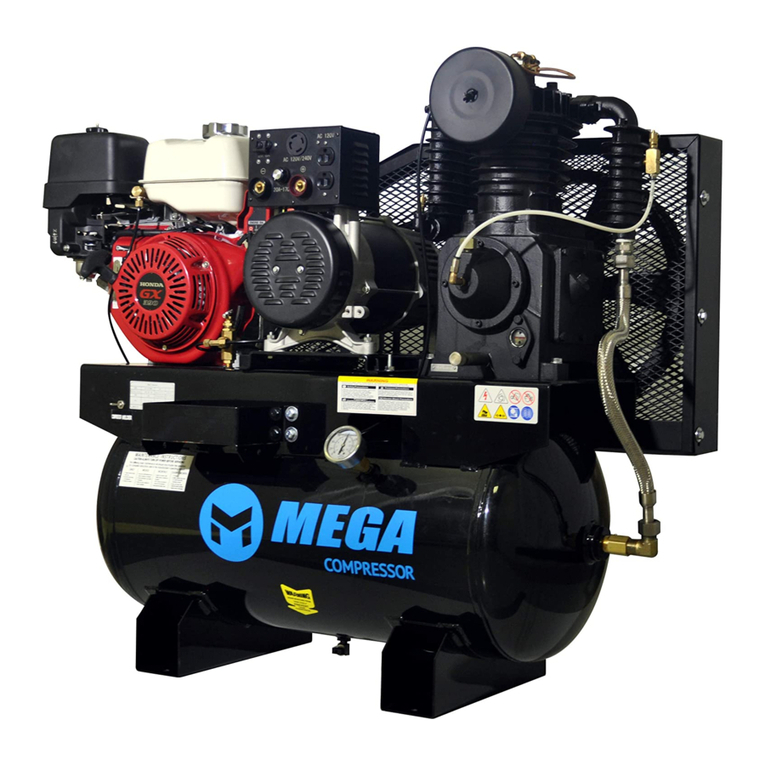
MEGAPOWER
MEGAPOWER MP-13030HWG Operator's manual
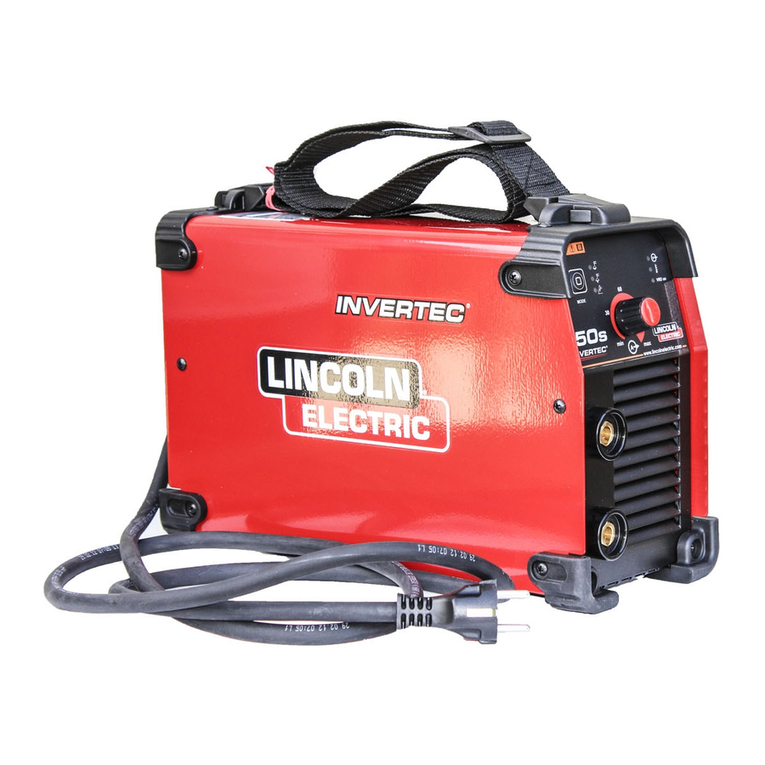
Lincoln Electric
Lincoln Electric Invertec 135S Operator's manual
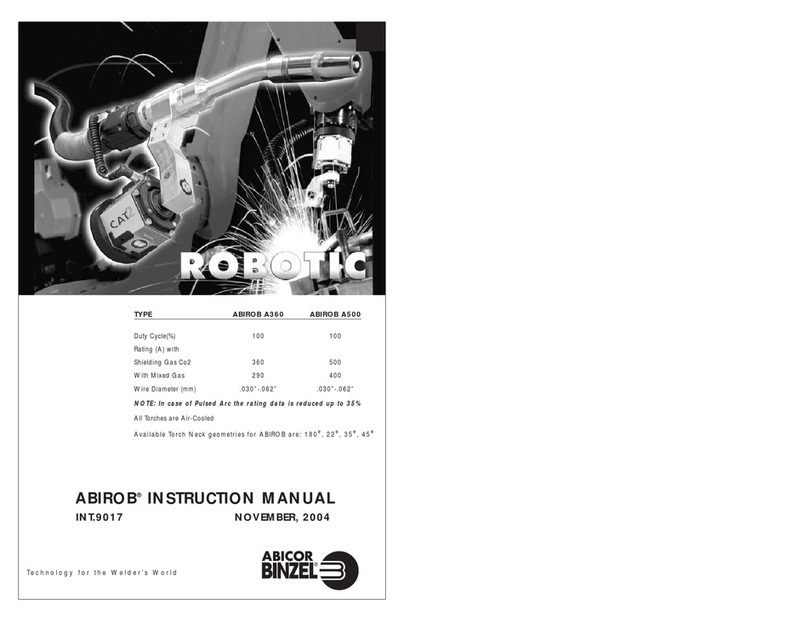
Abicor Binzel
Abicor Binzel ABIROB A360 instruction manual
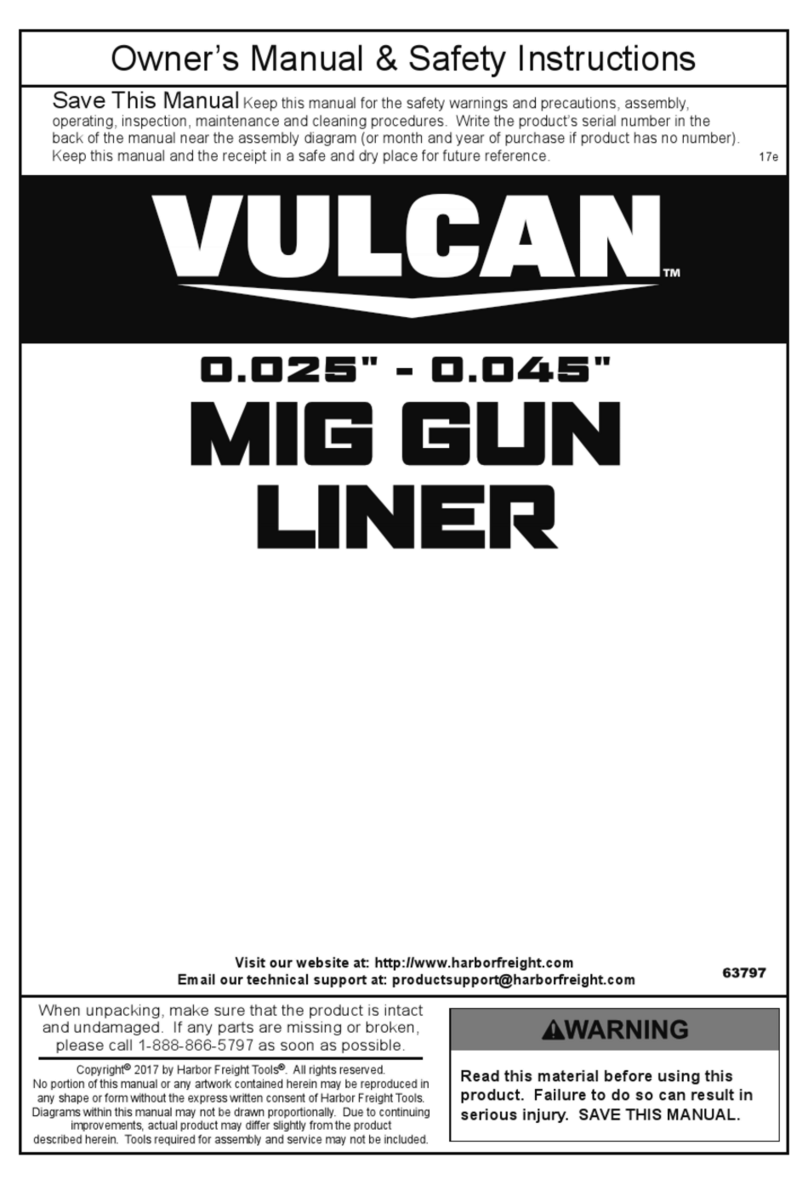
Harbor Freight Tools
Harbor Freight Tools VULCAN MIG GUN LINER Owner's manual & safety instructions
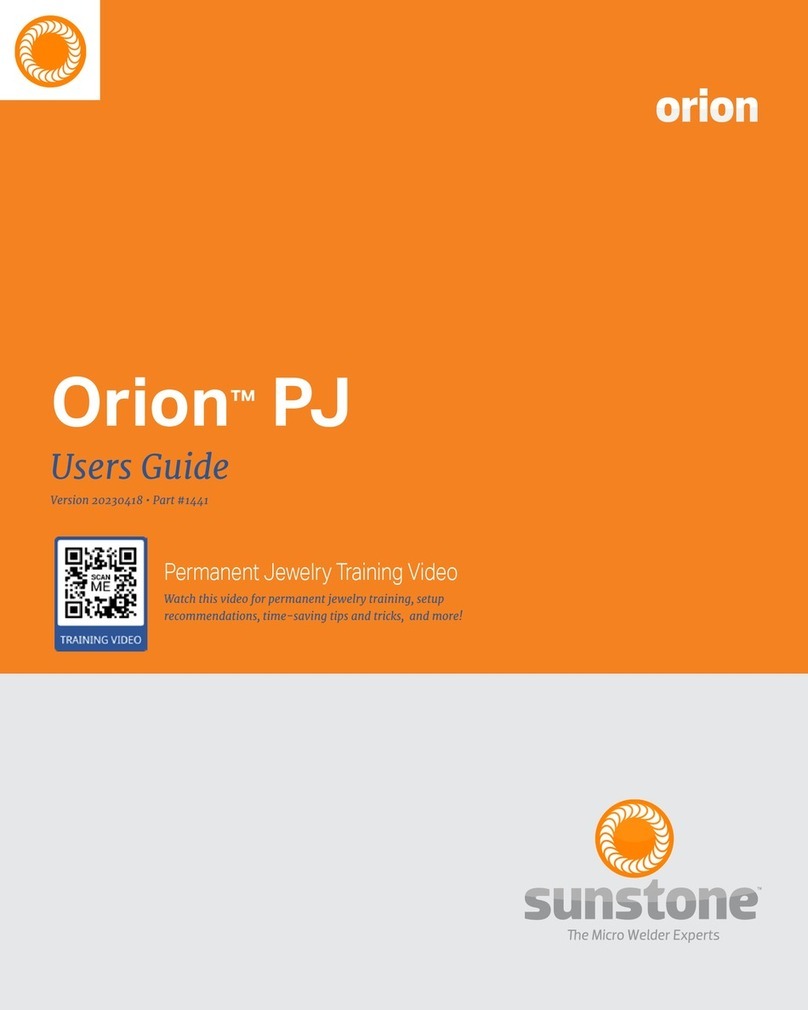
SUNSTONE
SUNSTONE Orion PJ user guide
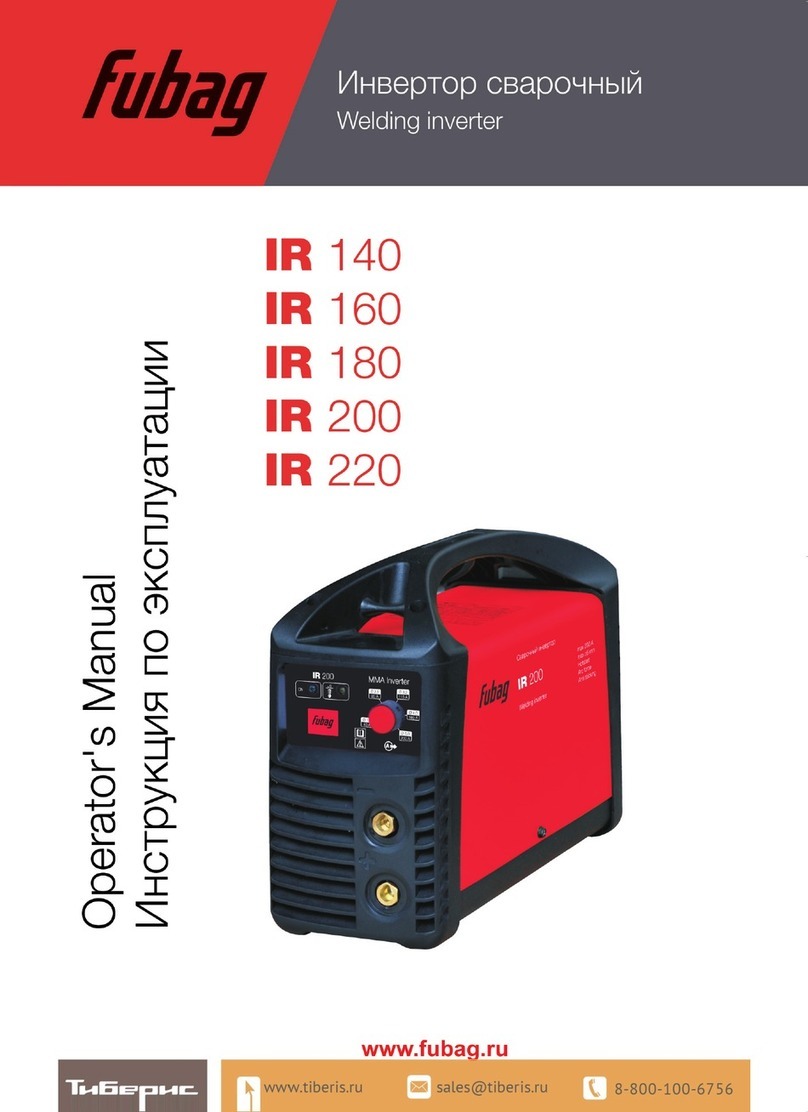
Fubag
Fubag IR 140 Operator's manual

Lincoln Electric
Lincoln Electric VANTAGE 400 (AU) Operator's manual
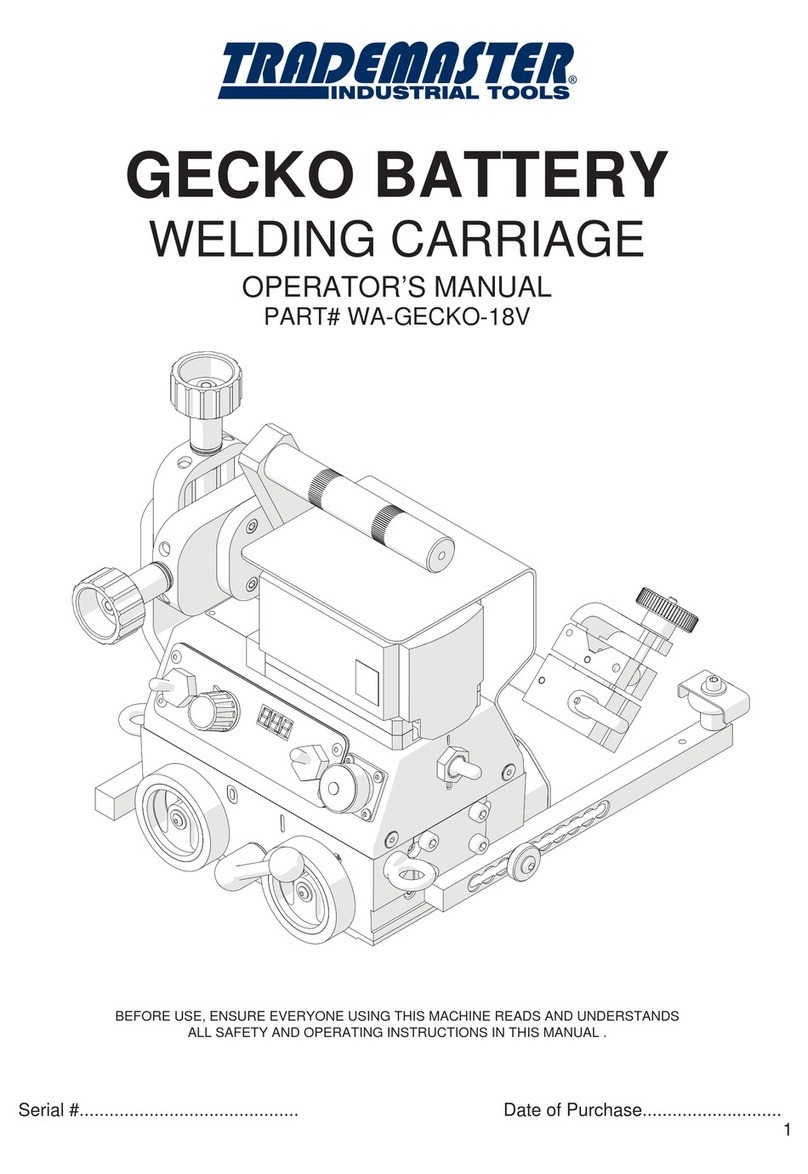
Trademaster
Trademaster WA-GECKO-18V Operator's manual
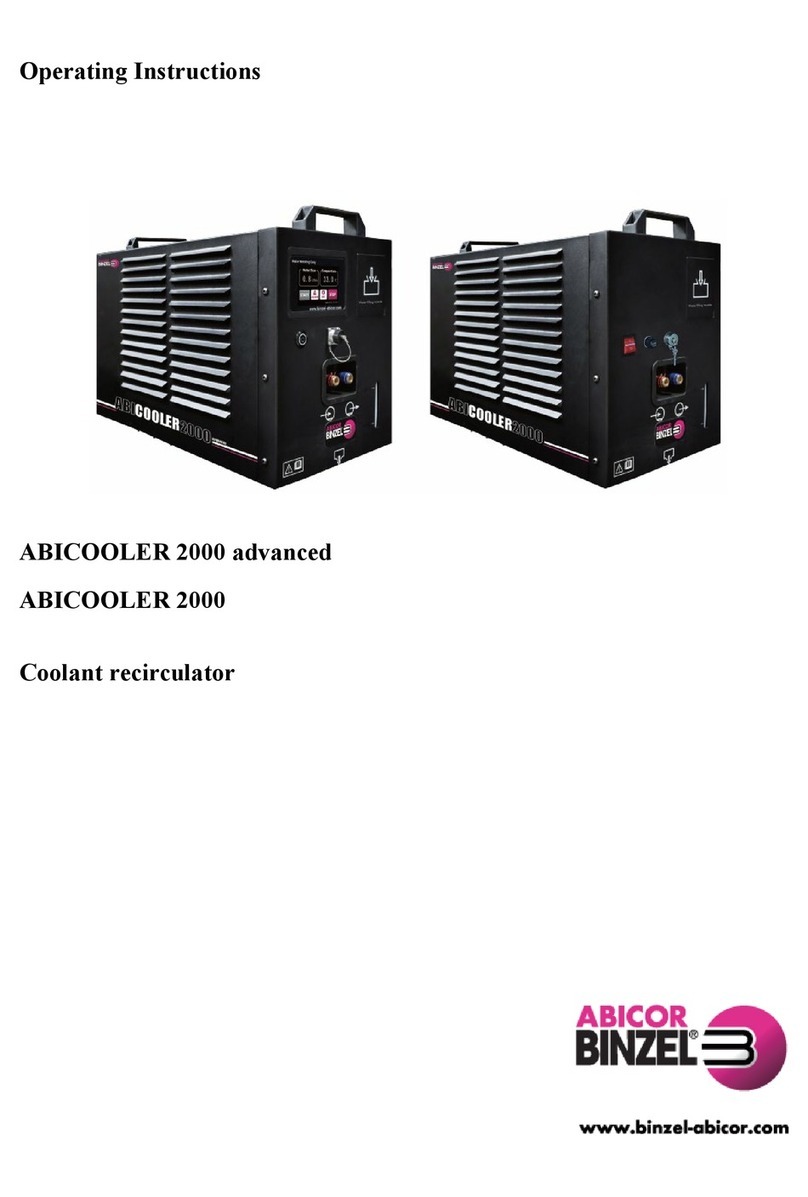
Abicor Binzel
Abicor Binzel ABICOOLER 2000 advanced operating instructions
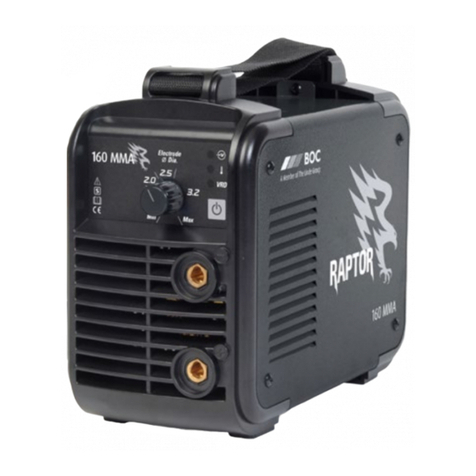
Linde
Linde BOC RAPTOR 140 MMA operating manual
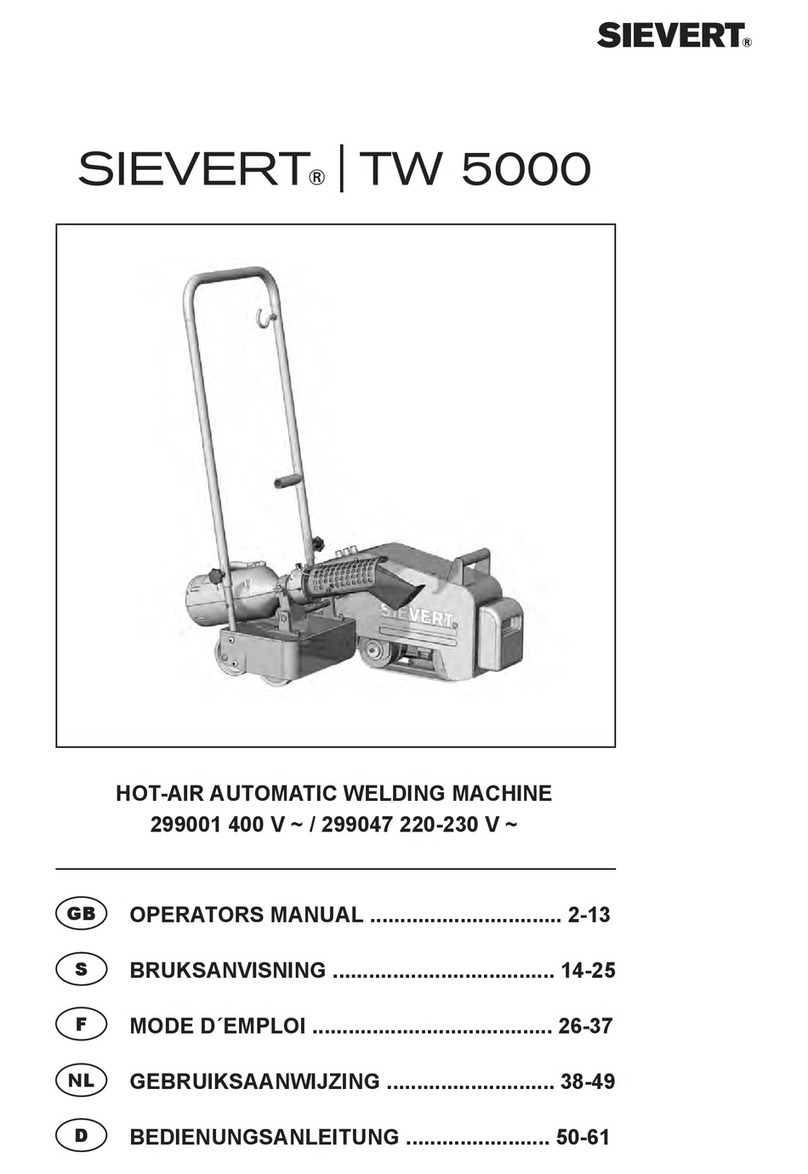
Sievert
Sievert 299001 Operator's manual
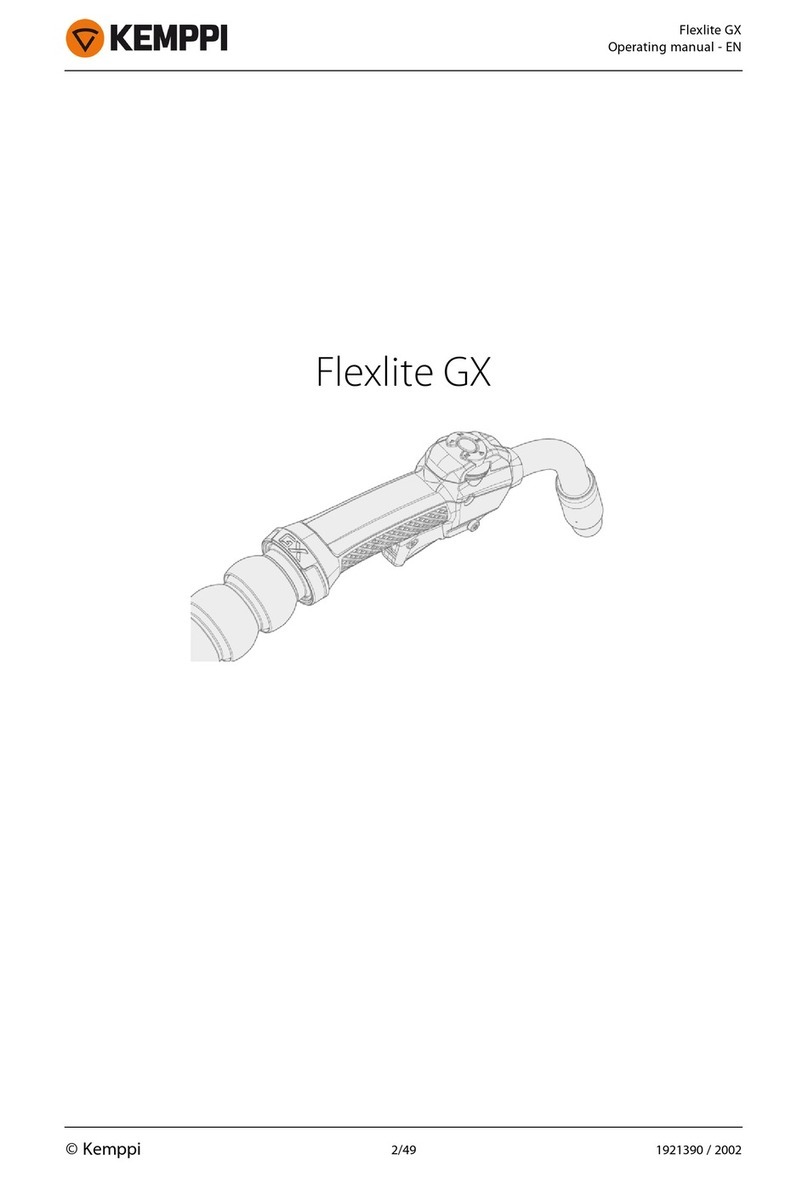
Kemppi
Kemppi Flexlite GX Series operating manual


